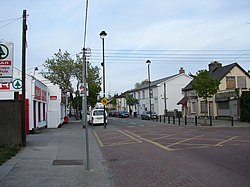Rathcoole, County Dublin
| Rathcoole Irish: Rath Cúil | |
| County Dublin | |
|---|---|
 Main Street, Rathcoole | |
| Location | |
| Grid reference: | O019268 |
| Location: | 53°16’58"N, 6°28’22"W |
| Data | |
| Population: | 3,421 (2011) |
| Local Government | |
| Council: | South Dublin |
| Dáil constituency: |
Dublin Mid-West |
| Website: | rathcoolevillage.com |
Rathcoole is an outer suburban village in County Dublin, south-west of the city of Dublin. It is in the Barony of Newcastle.
Name
The name of the village is believed to come from the Irish Rath Cúil meaning 'Ringfort of Comhaill'. There are several ringforts in the civil parish of Rathcoole; one in a field between the village and Saggart village. There is no definite explanation for the name 'Rathcoole'; if from Ráth Cumhaill ('Fort of of Cumhaill') it may refer to the father of Fionn mac Cumhaill. Alternative it may come from the Irish word for forest, "coill."
Location
Rathcoole stands in the southwest corner of County Dublin, just off the N7 primary road, west of Saggart village. Close by to the north are Baldonnel and Casement Aerodrome, home of the Irish Air Corps. Also in this part of the county are Newcastle and, further away, Brittas.
Geography
Around Rathcoole are several streams, primarily draining the western end to the Griffeen River but south of the eastern end linking to the River Camac, both tributaries of the River Liffey. Aside from the village core, the area has housing developments such as Beechwood Lawns, located between the main street and the park, Forest Hills, Broadfield Manor to the west, and Peyton to the south.
Historical notes
Like neighbouring Saggart, and nearby Newcastle, Rathcoole was on the periphery of the Pale and was the site of many battles with mountain-based rebels, particularly the Byrnes and O'Tooles.
The village had licence to hold a trading fair three times a year, a tradition which lapsed in the 19th century.
The village was the birthplace in 1765 of the United Irishman Felix Rourke, and another local, a member of the Clinch family of Rathcoole House, was executed after the 1798 rising.
In the late 18th century Rathcoole was composed mainly of mud huts,[1] and as late as the early 20th century it consisted of only one street.
Amenities
Rathcoole has a well-maintained landscaped municipal park at the eastern end of the village. There is also a community centre which caters for local events and training courses.
There is a small supermarket, a bank and a credit union, and two service stations on the N7. One of Rathcoole's best known pubs is An Poitin Stil, which is built on the site of an original inn dating back to 1649.Template:Cn The other pubs in the area are Muldowneys, Baurnafea House, and The Rathcoole Inn.
Rathcoole House
Rathcoole House was once part of a wider estate. The house was built in 1750 and initially belonged to the Clinch family, later passing to the Sheils of Coolmine, who owned it from 1831 to 1962. The house had two main floors above ground and five bays, with a kitchen, milling room and stores in the basement, and a hall, dining room and drawing room on the ground floor. Part of the house was demolished in 1933, and the remainder is now ruined.[2]
Sport
- Football: Rathcoole Boys Football Club
- Gaelic Athletic: Commercials Hurling Club
- Basketball: Rathcoole Rockets
- Golf: a number of golf courses are nearby, including Slade Valley, Citywest and Beech Park.
Coolmine Equestrian Centre was established here in 1989, providing horse riding lessons and guided horseback trips. This equestrian centre welcomes international guests here on educational programmes, work experience and holidays. The centre became an Equestrian Academy and is now known locally as CEAD-Ireland. This Academy hosts festivals during the summer, with dance, music, pony rides, pet farms, dog shows and equestrian competitions.[3]
Outside links
| ("Wikimedia Commons" has material about Rathcoole, County Dublin) |
- Rathcoole Community Centre
- Historyeye: Rathcoole, Liam Ua Broin and Brunton's Ghost
- Rathcoole Boys Football Club
- Coolmine Equestrian Centre
References
- ↑ Campbell, Thomas (1775). A philosophical survey of the south of Ireland (1733-1795) - Letter 7 (1775). Dublin, Ireland: Whitestone et al.
- ↑ "Pre-1850 houses: Rathcoole House". Local Government Mgmt. (Public Libraries of Ireland). http://www.askaboutireland.ie/reading-room/history-heritage/architecture/pre-1850-houses-in-south-/rathcoole/. Retrieved 20 March 2018.
- ↑ cead-ireland.com CEAD Ireland equestrian festival
